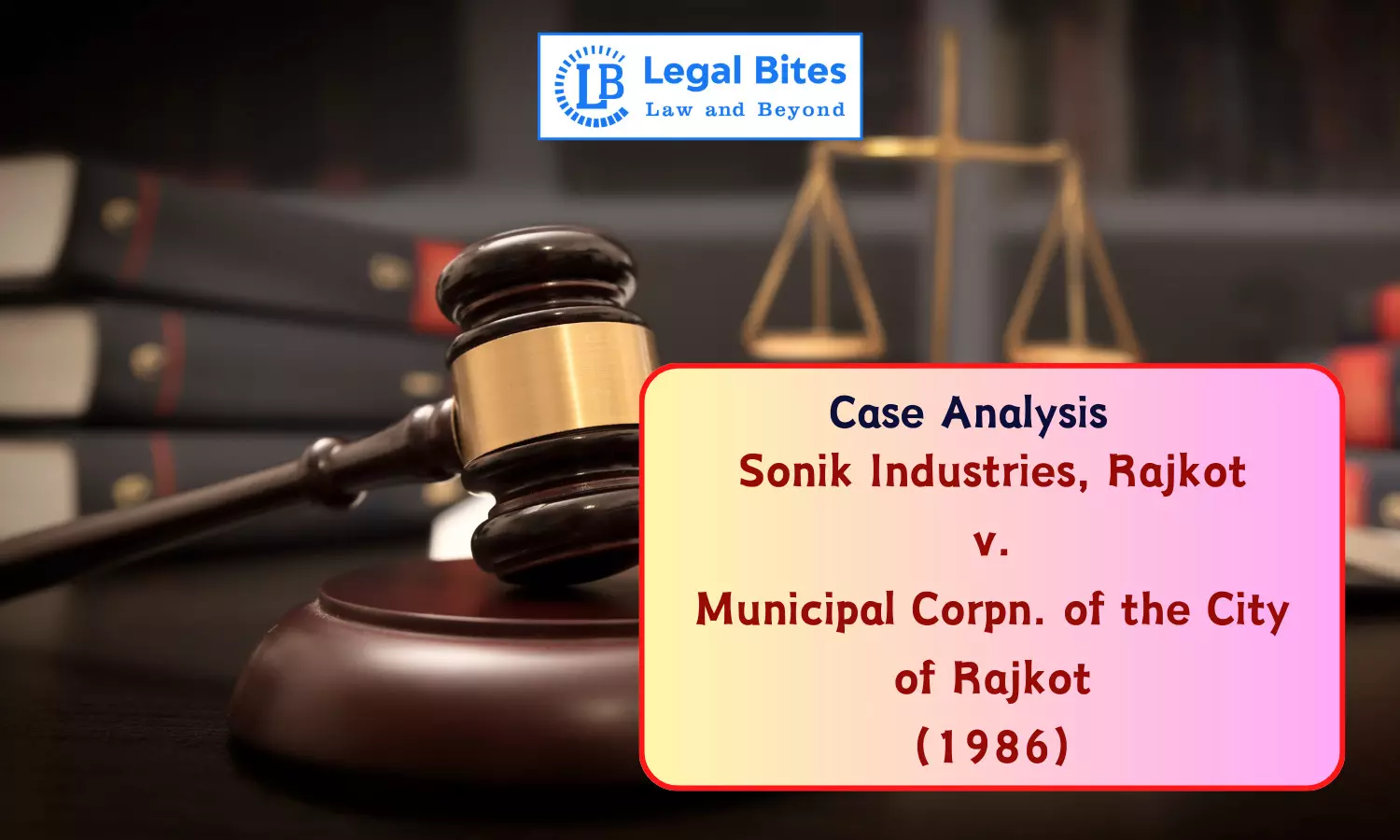Case Analysis: Sonik Industries, Rajkot v. Municipal Corpn. of the City of Rajkot (1986) | Delegated Legislation
This case primarily involves the scrutiny of a government action regarding rule publication under the Bombay Municipal Boroughs Act, 1925.

This case primarily involves the scrutiny of a government action regarding rule publication under the Bombay Municipal Boroughs Act, 1925 where a government action regarding rule publication was scrutinized concerning the procedure prescribed under Section 77.Case Title: Sonik Industries, Rajkot v. Municipal Corporation of the City of RajkotCourt: Supreme Court of IndiaCitation: 1986 SCC (2) 608Judges: Justice R.S Pathak, Justice O. Chinnappa Reddy and Justice R.B. MisraDate of...
This case primarily involves the scrutiny of a government action regarding rule publication under the Bombay Municipal Boroughs Act, 1925 where a government action regarding rule publication was scrutinized concerning the procedure prescribed under Section 77.
Case Title: Sonik Industries, Rajkot v. Municipal Corporation of the City of Rajkot
Court: Supreme Court of India
Citation: 1986 SCC (2) 608
Judges: Justice R.S Pathak, Justice O. Chinnappa Reddy and Justice R.B. Misra
Date of Judgment: 02/04/1986
Facts of the Case
The primary cause of action which initiated the said suit was the manifestation of the Rajkot Municipality's intention to levy rates on different types of buildings and lands within the Municipal limits of Rajkot.
In light of the same, the Rajkot Municipality framed draft rules on the levy of rates/taxes on certain class/classes of persons or property and made a publication stating that the State Government had also sanctioned such rules and objections to the same were duly invited, as required by law.
To better understand the facts of the case, a perusal of the provisions of laws in question i.e. Sections 75, 76, and 77 of the Act, would provide necessary context as to the laws involved and their application to the facts in the said case. These provisions establish certain procedural requirements required to be followed by the Municipality while publishing rules. A standard being laid down w.r.t the same is done in an attempt to ensure that every ordinary individual has a reasonable opportunity to become acquainted with these rules/laws and whether or not it would have any effect on them.
Section 75 of the Act requires that the Municipality pass a resolution elaborating on the type of rates/taxes desired to be levied and the class/classes of persons or property that they would be levied upon. Additionally, according to Section 75 of the Act, the basis of valuation on which such rates are charged is also to be disclosed. To these rules, as formulated by the Municipality, objections must be invited, and the Municipality is obligated to take in such objections/suggestions and make necessary modifications wherever required.
Section 76 of the Act empowers the State Government to sanction the rules with or without modification or to return them to the Municipality for further consideration.
Section 77 of the Act is as follows:
"Rules sanctioned under section 76 with the modifications and conditions, if any, subject to which the sanction is given shall be published by the Municipality in the Municipal borough, together with a notice reciting the sanction and the date and serial number thereof; and the tax as prescribed by the rules so published shall, from a date which shall be specified in such notice and which shall not be less than one month from the date of publication on such notice, be imposed accordingly."
The Rajkot Municipality thereby, made a publication in a newspaper titled 'Jai Hind' through the issue dated 28/11/1964 and also stated that the rules would take effect from 01/01/1985.
Thereafter, an assessment list was prepared and steps were taken to demand the tax.
After the preparation of such a list, the Appellants being a registered partnership firm, instituted a suit in the Senior Division of the Court of the Civil Judge, Rajkot, seeking not only a permanent injunction on the Municipality to refrain from implementing or giving effect to such rules but also praying for a declaration stating that the said rules were invalid and thus the consequent assessment and all other notices relating to the said rules in question were without the authority of law.
W.r.t the same, the Trial Court heard the matter and decreed it in favour of the Appellants, granting the declaration and injunction as prayed for.
The Municipality desired to appeal the decree of the Trial Court before the Extra Assistant Judge wherein such an appeal was dismissed.
Following this, a Second Appeal was preferred by the Municipality, before a Single Judge Bench in the respective High Court, which was subsequently referred to a larger bench for their opinion.
A larger Bench of the High Court observed that the conditions as set out under Section 77 had been complied with and also went on to state that the courts below had taken an erroneous view of the statute and that in their opinion, the conditions of Section 77 of the Act had been satisfied in the case.
Thus, the Learned Single Judge, upon consulting with the larger bench, allowed the second appeal. Hence, the appeal for Special Leave.
Issue of the Case
- Whether the rules for levying rates on buildings and lands can be deemed published under Section 77 of the Act, if the notice in a newspaper stating the State Government's sanction to the rules indicates that the rules are available for inspection at the Municipal office and copies can be purchased there.
Arguments
First and foremost, the primary contention of the Appellants, in this case, was that along with the notice reciting the sanction, the rules sanctioned by the State Government should have been published in the same newspaper and that failing which, such an act would not amount to a publication for Section 77.
Further implying that if the notice merely mentions that the rules can be inspected in the municipal office and that copies of the rules are available and can be purchased, instead of making them available with the relevant notices/intimation through publication would mean again that this was not a valid publication as per the requirements of law, as was the situation in the present case.
The Appellants also contended that the provisions of Section 77 should be construed/interpreted in a strict sense, since the rules are intended to levy a tax on the inhabitants of the Municipality, thereby having a large-scale public effect.
The Appellants also resorted to the interpretation of the object of such a requirement, being that a person affected by the levy of such rates/taxes must know precisely the provisions of the levy and its consequences for him.
Another contention disapproved by the Court was that the 1 month between the publishing of the rules and their coming into effect, is given to the people to enable persons adversely affected by such a levy to object to such rules, under Section 102 of the Act, and therefore the rules must be outlined in the newspaper itself.
Judgment
The mandatory requirement of law outlined in section 77 stipulated that the rules must be published and the bench hearing the matter believed that such a requirement was duly satisfied. But in reality, the Supreme Court stated that if through the means of communication/intimation used by the Municipality, it was reasonable enough for an ordinary man to become acquainted with whatever rules so published, the said method/medium through which notices were sent out would be sufficient.
The Supreme Court observed that since no stringent procedure for publishing was laid down by the Act, the said instance would have to be viewed liberally and there would be other determining factors for the validity of the manner of publication, as are being discussed. The Supreme Court turned to Section 102 which delineates the methods for serving a notice but doesn't address the mode for publishing the rules in question. Consequently, the Supreme Court was compelled to resort to the general principle that if the method of publication allows persons so affected to learn of the rules, then publication has legally occurred.
In response to the contention raised by the Appellants about the period of 1 month as per statutory provisions, the Supreme Court opposed such a contention entirely, stating that such a time frame is provided not for citizens to object, but to become acquainted with the rules and take necessary measures to properly implement those rules within the extent to which it affects them.
The Hon'ble Supreme Court held:
'There is no force in this appeal and it is accordingly dismissed with costs.'
Conclusion
This case, one which attracted the Civil Appellate Jurisdiction of the Supreme Court, paints a vivid picture of the system of appeals as remedies in our judicial framework. Individuals/Entities are given much more than 'adequate' safeguards against their rights and interests. However, the Supreme Court also established through this case, that where the Municipality has sufficiently fulfilled its responsibilities and requirements as per law, a person would not be allowed to take undue advantage of such remedial provisions made available to him, as was attempted in this case under Section 102 of the Act.

Aryan Udani
Aryan's key areas of interest are Environmental Law, Intellectual Property Law and Mergers & Acquisitions Law. Institution: Christ University
